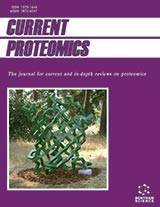Abstract
The interaction between proteins and sugars, termed as glycation has been a subject of increasing study over the past decade. The aim of the present study was to investigate the non-enzymatic interaction of thiol- proteinase inhibitor (cystatin) with three reducing sugars glucose, fructose and ribose. The behaviour of glycated cystatin was monitored by change in its hyperchromicity at 280nm, tryptophan fluorescence and Maillard fluorescence. The antipapain activity of glycated cystatin was found to be significantly lower than its non-glycated form. It was found that the incubation of cystatin with all the three sugars led to a parallel decrease in tryptophan fluorescence, enhancement in Maillard fluorescence and hyperchromicity in the UV-region. Among the three sugars studied ribose was found to be the most active in inducing structural and conformational alterations in the protein.
Keywords: Fructose, fluorescence, glycation, glucose, hyperchromicity, liver cystatin, maillard fluorescence, ribose, UV
Current Proteomics
Title:Spectral Methods of Characterizing the Conformational Changes of Glycated Goat Liver Cystatin
Volume: 9 Issue: 4
Author(s): Aaliya Shah, Mohd. Shahnawaz Khan, Medha Priyadarshini, Mohammad Aatif, Fakhra Amin and Bilqees Bano
Affiliation:
Keywords: Fructose, fluorescence, glycation, glucose, hyperchromicity, liver cystatin, maillard fluorescence, ribose, UV
Abstract: The interaction between proteins and sugars, termed as glycation has been a subject of increasing study over the past decade. The aim of the present study was to investigate the non-enzymatic interaction of thiol- proteinase inhibitor (cystatin) with three reducing sugars glucose, fructose and ribose. The behaviour of glycated cystatin was monitored by change in its hyperchromicity at 280nm, tryptophan fluorescence and Maillard fluorescence. The antipapain activity of glycated cystatin was found to be significantly lower than its non-glycated form. It was found that the incubation of cystatin with all the three sugars led to a parallel decrease in tryptophan fluorescence, enhancement in Maillard fluorescence and hyperchromicity in the UV-region. Among the three sugars studied ribose was found to be the most active in inducing structural and conformational alterations in the protein.
Export Options
About this article
Cite this article as:
Shah Aaliya, Shahnawaz Khan Mohd., Priyadarshini Medha, Aatif Mohammad, Amin Fakhra and Bano Bilqees, Spectral Methods of Characterizing the Conformational Changes of Glycated Goat Liver Cystatin, Current Proteomics 2012; 9 (4) . https://dx.doi.org/10.2174/157016412805219215
| DOI https://dx.doi.org/10.2174/157016412805219215 |
Print ISSN 1570-1646 |
| Publisher Name Bentham Science Publisher |
Online ISSN 1875-6247 |
 6
6
- Author Guidelines
- Bentham Author Support Services (BASS)
- Graphical Abstracts
- Fabricating and Stating False Information
- Research Misconduct
- Post Publication Discussions and Corrections
- Publishing Ethics and Rectitude
- Increase Visibility of Your Article
- Archiving Policies
- Peer Review Workflow
- Order Your Article Before Print
- Promote Your Article
- Manuscript Transfer Facility
- Editorial Policies
- Allegations from Whistleblowers
Related Articles
-
How to Investigate the Vascular Changes in Resistant Hypertension
Current Hypertension Reviews Antimicrobial Action of Chelating Agents: Repercussions on the Microorganism Development, Virulence and Pathogenesis
Current Medicinal Chemistry Neuronal Nitric Oxide Synthase and Sympathetic Nerve Activity in Neurovascular and Metabolic Systems
Current Neurovascular Research Amniotic Fluid Embolism: Review
Current Pharmaceutical Biotechnology Rheumatoid Arthritis: Notable Biomarkers Linking to Chronic Systemic Conditions and Cancer
Current Pharmaceutical Design Experimental Benefits of Sex Hormones on Vascular Function and the Outcome of Hormone Therapy in Cardiovascular Disease
Current Cardiology Reviews Inducers of Heme Oxygenase-1
Current Pharmaceutical Design Lectin-Like Oxidized Low-Density Lipoprotein Receptor-1 (LOX-1), a Relevant Target for Diabetic Vasculopathy?
Cardiovascular & Hematological Disorders-Drug Targets Hyperhomocysteinemia and Sudden Cardiac Death: Potential Arrhythmogenic Mechanisms
Current Vascular Pharmacology Image-based Computational Fluid Dynamics: A New Paradigm for Monitoring Hemodynamics and Atherosclerosis
Current Drug Targets - Cardiovascular & Hematological Disorders Harnessing Polypharmacology with Computer-Aided Drug Design and Systems Biology
Current Pharmaceutical Design Restless Legs Syndrome/Willis-Ekbom Disease and Periodic Limb Movements: A Comprehensive Review of Epidemiology, Pathophysiology, Diagnosis and Treatment Considerations
Current Rheumatology Reviews Cardiovascular Diseases and the Nitric Oxide Pathway
Current Vascular Pharmacology Angiotensin II-Induced Signaling Pathways in Diabetes
Current Diabetes Reviews HSP60 as a Drug Target
Current Pharmaceutical Design Cancer “Stemness”- Regulating MicroRNAs: Role, Mechanisms and Therapeutic Potential
Current Drug Targets MicroRNA-30 and 145 as Targets for the Treatment of Cardiovascular Diseases: Therapeutic Feasibility and Challenges
Current Pharmaceutical Design mTOR: A Novel Therapeutic Target for Diseases of Multiple Systems
Current Drug Targets Hypertension in China: Past, Present, and Future
Current Hypertension Reviews Effects of Nicotine During Pregnancy: Human and Experimental Evidence
Current Neuropharmacology























